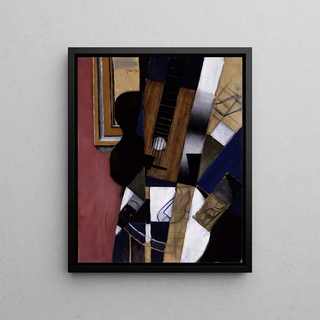Art print | Guitar and bagpipe - Juan Gris Source: Reproduction | Guitare et cornemuse - Juan Gris


View from behind

Frame (optional)
In the vibrant world of modern art, the "Guitar and Bagpipe" art print by Juan Gris stands out for its ability to transcend mere shapes and colors, offering a rich and immersive visual experience. This iconic piece, created in 1913, showcases the innovation of Cubism and the technical mastery of its creator. Delving into this work reveals a world where music and painting intertwine, evoking a visual melody that resonates with the very spirit of artistic creation. The art print of this piece allows appreciation not only of Gris's virtuosity but also of the emotion it evokes, paying homage to the depth of art.
Style and uniqueness of the work
The strength of "Guitar and Bagpipe" lies in its bold approach to Cubism. Juan Gris, as one of the pioneers of this movement, uses geometric shapes to decompose and reinterpret everyday objects. In this piece, the guitar and bagpipe, symbols of musical culture, are depicted through a palette of earthy colors and angular lines that create a captivating visual dynamic. The artist plays with shadows and lights, making the objects almost tangible while maintaining an abstraction that invites contemplation. Each element of the composition seems to dialogue with the others, forming a harmonious whole that celebrates the interconnectedness between music and the plastic arts.
The artist and his influence
Juan Gris, born in Spain in 1887, is often regarded as one of the masters of Cubism, alongside iconic figures such as Pablo Picasso and Georges Braque. His unique style, which combines geometric rigor with a sensitivity to color, has profoundly marked art history. Gris skillfully integrated various influences, ranging from Spanish tradition to Parisian avant-garde currents, creating a work that is uniquely his own. His ability to capture the essence of objects while deconstructing them paved the way for new artistic explorations, influencing generations of artists. Through "Guitar and Bagpipe," he reminds us that art is a universal language,

Matte finish

View from behind

Frame (optional)
In the vibrant world of modern art, the "Guitar and Bagpipe" art print by Juan Gris stands out for its ability to transcend mere shapes and colors, offering a rich and immersive visual experience. This iconic piece, created in 1913, showcases the innovation of Cubism and the technical mastery of its creator. Delving into this work reveals a world where music and painting intertwine, evoking a visual melody that resonates with the very spirit of artistic creation. The art print of this piece allows appreciation not only of Gris's virtuosity but also of the emotion it evokes, paying homage to the depth of art.
Style and uniqueness of the work
The strength of "Guitar and Bagpipe" lies in its bold approach to Cubism. Juan Gris, as one of the pioneers of this movement, uses geometric shapes to decompose and reinterpret everyday objects. In this piece, the guitar and bagpipe, symbols of musical culture, are depicted through a palette of earthy colors and angular lines that create a captivating visual dynamic. The artist plays with shadows and lights, making the objects almost tangible while maintaining an abstraction that invites contemplation. Each element of the composition seems to dialogue with the others, forming a harmonious whole that celebrates the interconnectedness between music and the plastic arts.
The artist and his influence
Juan Gris, born in Spain in 1887, is often regarded as one of the masters of Cubism, alongside iconic figures such as Pablo Picasso and Georges Braque. His unique style, which combines geometric rigor with a sensitivity to color, has profoundly marked art history. Gris skillfully integrated various influences, ranging from Spanish tradition to Parisian avant-garde currents, creating a work that is uniquely his own. His ability to capture the essence of objects while deconstructing them paved the way for new artistic explorations, influencing generations of artists. Through "Guitar and Bagpipe," he reminds us that art is a universal language,






